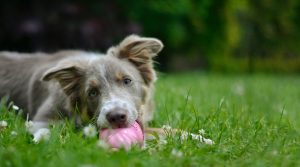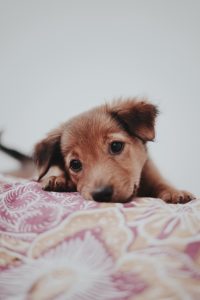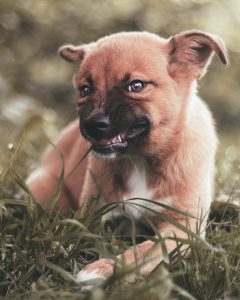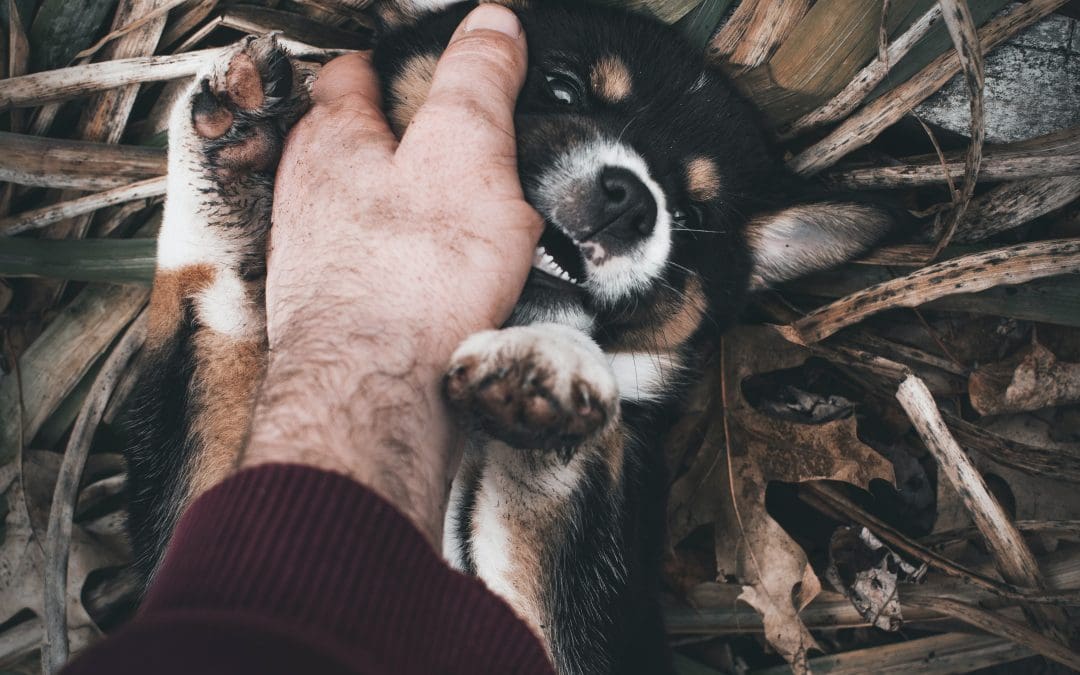Sure, those little fluffballs are undeniably adorable, but sometimes they can get a little too eager with their nibbling. It’s crucial to train them not to bite, not just for their own social skills, but also for the safety and comfort of everyone around them. 
In this blog, we’re going to explore five foolproof methods for effectively teaching your pup to curb their biting. We’ll dish out some practical tips and wisdom to guarantee a harmonious and enjoyable bond with your fluffy pal.
Why Puppies Bite
Puppies like to explore the world by putting things in their mouths, just like human babies do with their hands. When they were with their mom and siblings, they communicated by mouthing and biting. So, it’s totally normal for your little pal to want to nibble and chew, especially when they’re teething or feeling playful. But don’t worry, as they grow up, they’ll learn to control it. It’s all part of the process of training them on what’s okay to bite and what’s a no-go. And trust me, you definitely want to nail this down before they become big and strong!
Tried & True Methods to Curb the Teeth
Establish a Routine for Training
If you want your puppy to be the next canine Einstein, then you better stick to a routine and teach them not to munch on everything in sight. Dogs love a good old-fashioned schedule, so if you want your little buddy to get the memo, you’ll need to be consistent. Sending the same message and rewarding good behavior will make the learning curve smoother for everyone in the family.
Get your puppy in line by scheduling regular training sessions to teach them not to bite like little terrors. Forget about dragging it out with long, random sessions and opt for quick, frequent ones instead. This will keep your puppy from going stir-crazy and prevent them from getting bored. Find a quiet spot free from distractions to keep the training on track and make sure the whole family is on the same page with the schedule.
Positive Reinforcement, Positive Reinforcement, Positive Reinforcement!
If you’re trying to teach your pup not to nibble on everything in sight, try using a “no bite” command. When your furry friend obeys, treat them to some snacks, praise, and love if they use gentle mouthiness or refrain from chomping down. This positive reinforcement helps them connect not biting with good things happening, making it more probable that they’ll do it again.
Redirection is Key
No matter how hard you try, your little furball might still take a nibble at you. Don’t worry! Redirecting their attention is the key. When they go in for the nibble, steer them towards a more appropriate activity, like playing with a toy or chomping on a chew. Not only does this stop the biting, but it also channels their energy into something more socially acceptable. Puppies have a habit of going for our hands because they’re drawn to movement. If your little furball is always nipping at your fingers, just make a fist. It won’t be as entertaining to play with and your pup will probably lose interest.
Don’t forget to arm your fur baby with a variety of toys and snacks to steer them away from inappropriate nibbling. By giving them plenty of options for chomping, you’re basically saying, “Hey, this is what’s fair game and this is off-limits.” Keep these goodies on hand so you can swiftly steer their attention away from any forbidden bites.
What’s Appropriate and What’s Not
Training your dog to not chomp down on everything in sight doesn’t mean squashing their innate urge to gnaw. It’s more about steering them towards the right chew toys. Two key things to think about: getting them into the chew toy groove, and picking out the perfect toys for your furry friend.
-
The Chew Toy Introduction
When you give your pup their first chew toy, make it irresistible and captivating. Show your furry friend how awesome the toy is by getting in on the action and playing with it or giving it a good chomp. When your pooch shows interest, shower them with praise and cheer them on to build a positive connection.
It’s absolutely crucial to pick out the perfect chew toys for your little pup. Seek out toys specifically designed for puppies, made with gentle materials that won’t harm their tender teeth and gums. Skip the toys that look like household items to avoid any mix-ups. Opt for toys that can stand up to your furball’s relentless chewing.
The Keys to the Golden Ticket of Training
Training your little rascal not to nosh on everything in sight requires some serious dedication and a whole lot of patience. Stick with it, and remember that Rome wasn’t built in a day. Keep your cool when your pup is being a little menace, and don’t let setbacks get you down. Just remember, puppies are like little explorers still figuring things out. They won’t become biting saints overnight. Stay consistent with your training, and steer their gnawing towards more positive activities. It might take a while, but your fur baby will get the hang of it eventually. If furball won’t stop nibbling on everything despite all your efforts, sometimes it’s enough to make anyone want to throw their hands up in defeat. But hey, setbacks happen to the best of us, so take a deep breath and remind yourself it’s just a bump in the road. Stick to your training game plan and be flexible enough to switch it up if necessary. And don’t be afraid to reach out to fellow dog parents or experts for some fresh ideas and a little extra motivation. 
How to Handle the Nibbles in Other Environments
Biting can happen in all sorts of situations, like when you’re having fun or hanging out with other dogs. If you want to teach your puppy to behave, you have to handle these situations in different ways. Here are a couple of approaches: how to deal with biting when you’re playing, and how to deal with biting in social settings.
-
Teeth During Playtime
If your puppy gets little too worked up during playtime and start nipping or biting, be sure to immediately stop the game whenever the biting starts and establish clear boundaries. This not only makes the rules clear to your pup, but also prevents any backlash from their play partner.
-
Social Environments
It’s absolutely crucial to stay on top of your puppy’s nibbling tendencies when they’re socializing with other pooches or humans. Pay close attention to your pup’s physical cues. Watching dogs interact can seem a tad intimidating to us humans, with all the growling, barking, and nipping. But it’s vital to grasp the natural way dogs communicate with each other.
Last Resort: Leave it to the Professionals
No matter how hard you try, your little puppy might keep on chomping or even step up their biting game in certain situations. If you’re feeling like you’re in over your head or just plain stumped on what to do next, don’t hesitate to call in the big guns. Here are a couple of things to think about when deciding if you need to bring in the pros, as well as the perks of having a professional dog whisperer on your team. 
When your precious pup’s chomping antics start to resemble a scene from a horror movie, happen all the time, or just won’t quit no matter how much you try, it’s probably a good idea to call in the big guns. A top-notch dog whisperer can swoop in, size up the situation, and dish out some customized tips to tackle the one-of-a-kind problems you and your dog are facing.
Last Words of Advice
Teaching your pup not to nibble requires a whole lot of patience, sticking to a routine, and using some good ol’ fashioned training techniques. By understanding the significance of bite control, establishing a routine, dishing out some positive rewards, addressing any nipping, and showing them what’s cool to chew on, you can help your furry friend become a well-behaved and affectionate buddy.
Just a friendly reminder that teaching your pooch new tricks isn’t an overnight job, be sure to remain patient and give them a round of applause when they nail it. And if you start to notice your furry friend getting a little too nippy, don’t hesitate to call in the experts for a little backup. Better to nip that problem in the bud, right? 
With a little elbow grease and a well-thought-out plan, you can teach your fur baby to be a well-behaved and gentle little friend.

